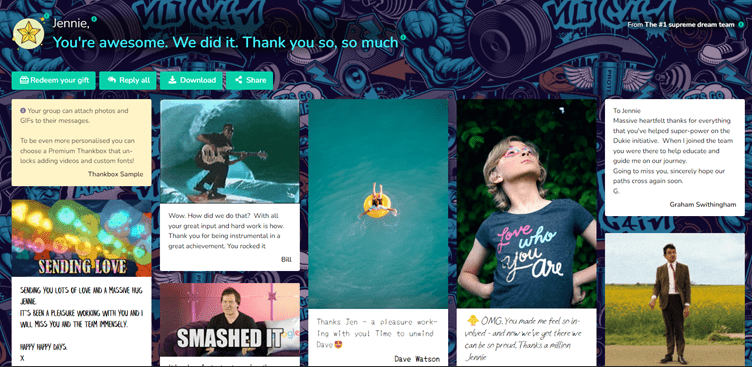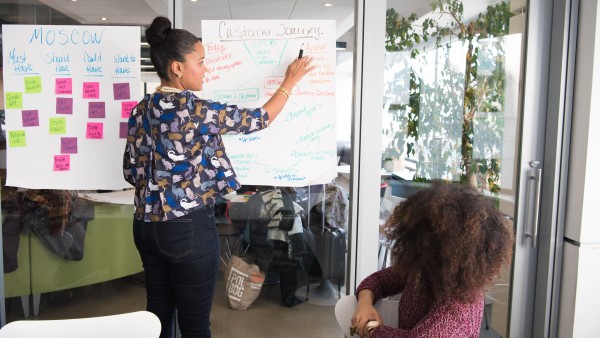Fostering Flexibility: Our 8 Tips for Building an Agile Work Environment


Rigid workplaces are slowly but surely losing their grip on the modern workforce. More and more companies are recognizing the benefits of giving employees the flexibility they need to thrive in their roles.
That’s where agile work comes in – an approach that values collaboration, adaptability, and continuous improvement.
Not sure what an agile work environment looks like? Want to know how to create one for your team? Look no further—join Thankbox as we uncover the secrets to building an agile work environment for your employees to thrive.
Let’s get started!
What is an agile work environment?
Agile working is a flexible and decentralised style of working that’s not defined by hourly schedules, where employees do their work, how employees work together, and what employees work on in the first place.
Agile working is a free-form approach that rejects the traditional concept of the workplace, aiming to improve flexibility, adaptability, employee motivation and collaboration. And, if implemented well, it can have a major, positive impact on performance.
The major characteristics of an agile workplace include:
Innovation and collaboration: By supporting collaboration and brainstorming between different departmental teams, employees can build stronger professional bonds and boost creativity.
Workspace flexibility: The workplace is adapted to be more open, so employees can move about freely and make use of the different workspaces available. For example, having multiple teams in one office to boost collaboration, or employees choosing whatever setting best suits the task they’re doing at a certain time, or incorporating hybrid working schedules.
Adaptability and responsiveness: Since agile workplaces are more dynamic, they are better equipped to adapt to unforeseeable shifts without completely disrupting effective workflows.
Focus on employee and customer satisfaction: Agile work environments tend to prioritise employee well-being and comfortability to ensure that they can deliver their best output to clients.

Why is an agile work environment important?
Agile workplaces offer a range of advantages for both employees and managers, including:
Greater autonomy and flexibility: Employees get the choice of where they can work to suit their current tasks and preferences which fosters growth and development of more dynamic working styles.
Cultivating a positive company culture: With greater autonomy in the workplace, employees feel greater job satisfaction and are motivated to show their value for the good of the team.
Free communication and collaboration: The openness that agile workspaces encourage may lead to a more integrated work culture, which promotes productivity and creative problem-solving.
Employee empowerment: With the freedom of self-management, employees feel more empowered, valued, and trusted.
Ability to recruit top talent: For employers, having an agile work environment makes it easier to recruit and retain a more diverse workforce.
The secret sauce to building an agile work environment is cultivating seamless collaboration. What better way to do that than with Thankbox? Create one today and show your team that their hard work is appreciated.
Our 8 tips for building an agile work environment
Your agile work environment will be unique to your organisation and company culture. That means how you structure and build it will depend on what policies you have in place and what your employees need.
That said, we can offer some tips to help you get started:
1. Bring your team together
An amazing way to make your workplace more agile is by creating a sense of connectedness in the office. What better way to do this than by continuously encouraging peer recognition and celebrating milestones?
With Thankbox, it’s easy to make employee appreciation a core element of your culture.

Our online group greeting card allows you to involve your entire team in expressing their appreciation in a personalised way. You’ll be able to create and send stylish messages full of GIFs, photos, and videos to celebrate personal and team achievements.
The best part is, you’re not limited to celebrations—you can also bring the team together to create a get-well-soon card or express sympathy and condolences. You could even go a step further by including a group gift card (redeemable at over 700 retailers).
It’s the best way to show employees they’re appreciated, boost staff morale, and keep everyone engaged in an agile work environment.
2. Clear planning
Clear and strategic planning is essential for any organisation looking to be more agile.
Set clear goals and expectations, and regularly communicate progress and updates with the team. Your agile work environment will give employees flexibility in how they achieve these goals—but the goals themselves are defined.

3. Encourage clear and friendly communication
A common challenge that comes with an agile work environment is the potential for miscommunication because it can be pretty difficult to communicate clearly and openly with a dynamic workforce.
Here, your communication skills will be a valuable asset.
Establish friendly and centralised communication flows for your employees, and choose an inclusive method for informing them of super important information. Also, remember to stay precise and specific, so there’s little room for miscommunication.
4. Maintain accountability
While you’re trying to build a more flexible workplace, it’s important to hold teams accountable for their daily work. This doesn’t mean playing a blame game when things go wrong, but also recognizing when things are going right.
Start incorporating new projects into specific teams’ workflows from the beginning to foster greater accountability and responsibility.
5. Provide training when your team needs it
Since agile working can be a pretty dramatic shift from traditional office environments, it’s important to train employees in areas where they may need extra support. That could be in remote communication, time management, or project management skills.

For example, lots of employees are used to having their tasks assigned to them.
If your agile work environment lets employees choose what they want to work on, it might be useful to train them on different ways to prioritise tasks.
6. Support work-life balance
Although the agile approach can be quite positive for many employees, there’s always the chance of some employees having a not-so-good experience. You’ll need to monitor employee engagement closely and watch out for those who may be feeling overwhelmed and going through burnout.
Consider implementing policies that support a healthy work-life balance, like hybrid work schedules, weekly mental health check-ins, or wellness workshops.
The secret sauce to building an agile work environment is cultivating seamless collaboration. What better way to do that than with Thankbox? Create one today and show your team that their hard work is appreciated.
7. Improve team collaboration spaces and tools
An agile work environment is highly collaborative. So, you’ll need to make sure to facilitate this collaboration by creating spaces for teamwork and introducing some changes to team structures.
For example, you could establish social spaces (both physical and digital) where employees are free to have informal meetings and brainstorming sessions together. By having the freedom to bond during breaks, it can lead to better teamwork during working hours.

To improve the collaboration across departments, you’ll also need some tools to help management. Take a look at our selection of essential HR tools that you can use to track employee activity and performance, as well as identify which projects tend to bring up the most issues.
8. Keep collecting feedback
In an agile work environment, your team is likely to be bursting with new ideas and insights to improve their efficiency. It’s in your best interest to capture these ideas through feedback and suggestion boxes.
You can keep it anonymous to encourage your employees to keep sharing without hesitation.
Wrapping up
As times change, people change too, and when this happens your previous working methods may not be a great fit. If you want to elevate your team, you can’t keep them away from new concepts like the agile working environment. Hopefully, our guide has given you the first steps you need to get you embracing flexibility.
To take this step, your team needs to be connected. Luckily, at Thankbox, our unique platform offers an innovative and sustainable way to bring your team together.
Create a Thankbox today and let your team know how much each of them is valued!
Images: Cover | Employees discussing a project | Team discussing graphs and rates | Two businesswomen in a meeting | People looking at a laptop





